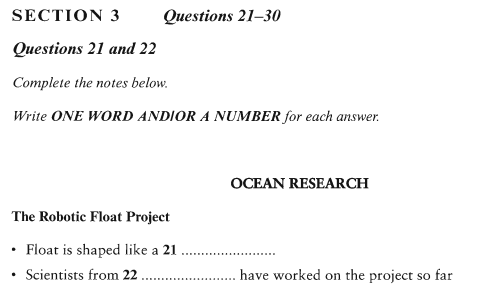剑桥雅思7听力:Test3雅思听力Section3真题+答案+解析
发布时间:2020-12-10 关键词:剑桥雅思7听力:Test3雅思听力Section3真题+答案+解析剑桥雅思7听力:Test3雅思听力Section2真题+答案+解析,我们一起来看看吧!
Thanks to all of you for coming along today to hear about how therobotic float project is helping with ocean research. Well, first of allwe'll look at what a robotic float does and its use. So let's start withthe device itself. It looks a bit like a cigar and it's about one and a halfmetres long. More importantly it's full of equipment that's designedto collect data. So, it can help us in building up a profile of differentfactors which work together within the world's oceans.
Sounds like a big project - isn't it too big for one country to
undertake?
That's quite true but this project is a really good example of
international co-operation. Over the last five years scientists fromthirteen countries have been taking part in the project and launchingfloats in their area of ocean ,control. And next year this number willrise to fourteen when Indonesia joins the project.
That's impressive.
But let's move onto how floats work.
The operational cycle goes like this. Each of the floats is dropped inthe ocean from a boat at a set point and activated from a satellite.Then the float immediately sinks about 2,000 metres. . . that's two
whole kilometres down in the water. It stays at this depth for about 10days and is carried around by the currents which operate in the oceanat this level. During this time it's possible for it to cover quite largedistances but the average is fifty kilometres.
So what is it actually recording?
Well at this stage nothing, but as it rises to the surface it collects allsorts of data, most importantly variations in salinity, that's salt levels,and tbe changes in temperature, a bit like underwater weather balloons.Then when it gets back to the surface all the data it's collected is
beamed up to the satellite. After about five hours on the surface thefloat automatically sinks, beginning the whole process again.
What happens to the data?
Well the information is transferred direct to onshore meteorologicalstations. . . like our one in Hobart. . . and within four hours the
findings can be on computers and they can be mapped and analysed.
You say you're building models of the world's ocean systems buthow're they going to be used, and more importantly, when?
Some of the data has already helped in completing projects. Forexample, our understanding of the underlying causes of El Niño
events is being confirmed by float data. Another way we re using floatdata is to help us to understand the mechanics of climate change, likeglobal warming and ozone depletion. That's part of an ongoing
variability study but the results are still a long way off.
However, this is not the case with our ocean weather forecasting.
Because we know from the floats what the prevailing weather
conditions will be in certain parts of the ocean, we can advise thenavy on search and rescue missions. That's happening right now andmany yachtsmen owe their lives to the success of this project. In
addition, the foat data can help us to look at the biological
implications of ocean processes.
Would that help with preserving fish stocks?
Yes, and advising governments on fisheries legislation. We're well onthe way to completing a project on this. We hope it will help to bringabout more sustainable fishing practices. We'll be seeing the results ofthat quite soon.
It sounds 1ike the data from floats has lots of applications.
Yes it does. It's also a powerful agricultural tool. If we were aware ofwhat the weather would be like, say, next year, we could make surethat the farmers planted appropriate grain varieties to produce thebest yield from the available rainfall.
That sounds a bit like science fiction, especially when now we can'teven tell them when a drought will break.
I agree that this concept is still a long way in the future, but it willcome eventually and the float data will have made a contribution.
感谢大家今天来听漂浮生物项目对海洋研究的帮助。首先,我们来看看机器人浮舟的作用和用途。让我们从设备本身开始。它看起来有点像雪茄,大约有1.5米长。更重要的是,这里到处都是用来收集数据的设备。所以,它可以帮助我们建立一个概况,不同的因素共同作用在世界的海洋。
听起来像是一个大项目,对一个来说是不是太大了
承担?
这是真的,但是这个项目是一个的例子
国际合作。在过去的五年里,来自13个的科学家一直在参与这个项目,并在他们的海域发射浮舟,控制。明年,当印尼加入该项目时,这个数字将上升到14个。
这是令人印象深刻。
让我们来看看浮动是如何工作的。
操作周期是这样的。每个漂浮物都是在一个设置点从船上扔到海里,然后由卫星启动。然后浮子立即下沉约2000米……这是两个
在水下几公里处。它会在这个深度停留大约10天,并被在这个深度的洋流带着。在这段时间内,它有可能跑很长的距离,但平均是50公里。
那么它到底在记录什么呢?
在这个阶段什么都没有,但是当它上升到表面时,它会收集各种数据,最重要的是盐度的变化,也就是盐的水平,以及温度的变化,有点像水下的气象气球。当它回到地面时,它收集的所有数据
向卫星发射。在水面上停留约5小时后,浮子会自动下沉,整个过程又开始了。
数据会发生什么变化?
这些信息被直接传送到岸上的气象台…就像我们在霍巴特的那个…在四个小时内
研究结果可以在电脑上显示,可以进行映射和分析。
你说你在建立世界海洋系统的模型,但它们将被如何使用,更重要的是,什么时候使用?
一些数据已经帮助完成了一些项目。例如,我们对厄尔尼诺潜在原因的理解
事件由浮动数据确认。我们使用浮动数据的另一种方式是帮助我们理解气候变化的机制,比如全球变暖和臭氧损耗。这是正在进行的工作的一部分
变异性的研究,但结果仍然是一个漫长的路。
然而,我们的海洋天气预报却不是这样。
因为我们从浮舟上知道当时的天气
海洋的某些部分会有条件,我们可以为搜救任务提供建议。这就是现在正在发生的事情,许多游艇驾驶员都将他们的生命归功于这个项目的成功。在
此外,foat数据可以帮助我们观察生物学
海洋过程的影响。
这会有助于保护鱼类资源吗?
是的,并且就渔业立法向政府提供建议。我们在这个项目上进展顺利。我们希望这将有助于带来更可持续的捕鱼方式。我们很快就会看到结果。
听起来像是来自float的数据有应用。
的确是的。它也是一种强大的农业工具。如果我们知道天气将会怎样,比如说,明年,我们就可以确保农民种植合适的谷物品种,以利用现有的降雨获得产量。
这听起来有点像科幻小说,尤其是现在我们甚至不能告诉他们干旱何时会结束。
我同意这个概念在未来还有很长的路要走,但它最终会到来,浮动数据会做出贡献。


师资点题剑桥雅思7听力:
考题精解
Question 21 cigar
考生首先听到录音中男老师介绍说… the robotic float project... 然后,老师说到... let’s start with the device itself... 考生就应该意识到21题的答案即将出现。后面紧随着it looks like a cigar。所以cigar为正确答案。
Question 22 13 (different) countries
女生首先提出问题... isn’t it too big for one country to undertake,这就是22题的问题。所以只要听取接下来老师的回答就能抓出正确答案。但是,该题的题干有一个小陷阱:题干的时态是完成时,说明问的是已经参加的,而不是没有参加的。因为考生还能听到14,但是Indonesia是还没有参加的,所以不是正确答案。
Question 23 activated
此题开始是一组标签题。考生需要读图,该图的标题the operational cycle为指示词,而本题的另一个指示词为satellite。考生只要抓好这两点,就能听到答案。activated使用被动形式,要正确拼写。
Question 24 50 km(s)
本题的题干指示词为average distance。考生需要认真听取指示词的出现。答案在转折词but以后出现。
Question 25 temperature
当听到录音中女生问... what is it actually recording,考生应意识到25题的到来,男老师回答中的salinity已经在题干中给出来,帮助考生定位正确答案。所以当考生听到and the changes in temperature就能确定答案了。
Question 26 A
当考生听到女生问... but how’re they going to be used, and more importantly, when?考生应该意识到26题的到来。El Nino是这道题的关键指示词。所以当考生听到 … has already helped ... for example... El Nino ... 就能肯定答案。本题对时态要求较高,需要考生注意。
Question 27 C
当考生听到录音中出现... climate change意味着27题的到来,后面出现了转折... but the results are still a long way off。一般情况下,转折后都有考点出现,所以可以确定答案。
Question 28 A
当听到录音中男老师提到… we can advise the navy on search and rescue missions… 对应题目中的naval rescues,考生应意识到28题的到来。…that’s happening right now… 提示正确答案。
Question 29 B
考生可以清楚地听到录音出现完整的题干... sustainable fishing practices。正确答案紧随其后… we’ll be seeing the results of that quite soon。“quite soon”提示答案。
Question 30 C
考生听到... agricultural tool... grain varieties ...时,应该意识到答案的出现。本题需要考生的耐心。因为正确答案一直到最后才出现… a long way in the future。




